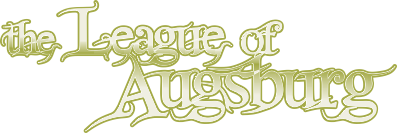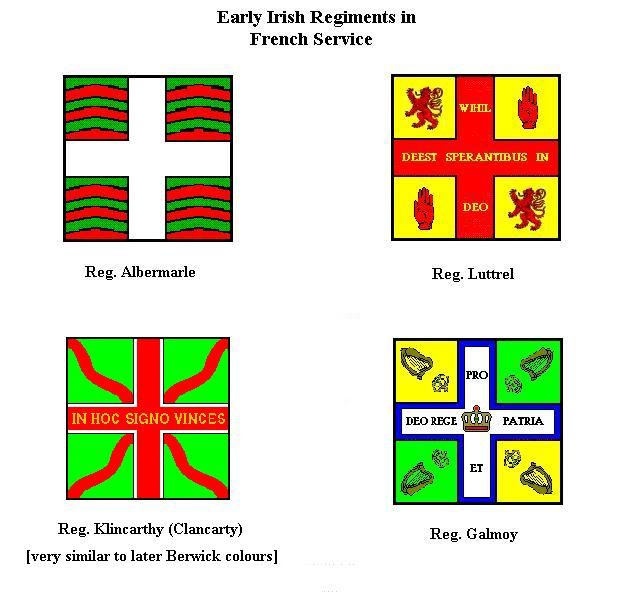Post
by Sir William » Thu Sep 01, 2011 8:57 pm
Barry,
Here is O'Callaghan's text specifically on the Dublin Regiment (minus several footnotes, of which O'Callaghan is very fond):
THE INFANTRY REGIMENT OF DUBLIN.
The "Regiment de Dublin, Infanterie," appears to have been so called in France, from having been first levied, on the breaking out of the War of the Revolution in Ireland, by Sir Michael Creagh, Knight, Lord Mayor of Dublin for 1688-9, Member, also, for Dublin in the Parliament of the latter year, and Pay-Master-General of the Forces in Ireland to King James II. The corps was all raised in Dublin, where the Colonel had much property. The name of Creagh, anglicized from an old Irish word meaning a branclt-bearer, was, according to family tradition, originally O'Neill—of the North Mimster or Dalcassian sept of Tradraidhe or Tradry, County of Clare*—until connected with the annals of Limerick, the rank of General of Brigade, adds—"He was a small man, rather handsome, with fine features," and, "having been born and brought up in Ireland, be spoke English. He bad the reputation of being a just chief, though a severe disciplinarian, and a strict observer of military rules and honours. Though proud and haughty as one of the descendants of the great O'Neill of the North, still he was much liked by his officers," who "used to call their Colonel, 'the Monarch,' in their chat anions' themselves."—His son, Charles O'Neill, born in France, September 29th, 1770, became, April 22nd, 1788, a Sous-lieutenant in the Regiment of Walsh; and in the course of the wars under the Republic, the Empire, and subsequent bo the Restoration of the Bourbons, rose to be a Colonel, an officer of the Legion of Honour, and Chevalier of St. Louis, &c He was wounded, and made prisoner, November 4th, 1799, at the battle of Fossano. He served at sea in the Jupiter, the Valcureuee, and the Couragrux, from June, 181>4, to November, 1807. In the Peninsular contest, which he passed through from 1S08 to 1812, he received a contusion on the left arm, at the 1st siege of Saragossa; and, at the battle of Salamanca, in command with his battalion of Voltigeurs, was disabled in the left foot, from a gunshot wound, and made prisoner by the English. Though sent back to France, in April, 1813, as so seriously injured, and notwithstanding bis consequent severe suffering, he headed a battalion of National Guards in the decisive campaign of 1814, where he was engaged at the affairs of Meaux, of Claye, and in the defense of Paris. Afterwards, or in 1823, at the head of the 27th Regiment in Spain he was distinguished, July l6th, before the Isle of Leon. He held the appointment of Chief of the Bureau of Infantry till the Revolution of July, 1830, and died at Paris, in July, 1844. He appears to have been an honour even to the honourable name he bore; a good comrade and friend; ever willing, while employed in the War Office, to oblige his father's countrymen. He was very fond of music, and both sang wcli, and played on several instruments. in the territory of their ancestors till our time; among whom the tradition relative to the Creaghs hag been preserved. Under too many circumstances long unfavourable to the retention of the name of O'Neill, in its old form, some of this Clare race modified it into Nihell, or Nihill. My Limerick authority in 1787 writes—" Of this family" of Nihell "is Baron Harrold, a native of Limerick, and Colonel of the Regiment of Koeningsfeldt, in the German service. Several of them have served Tiononrably in the Irish Brigades on the Continent. Lieutenant-Colonel Nihell of Dillon's regiment particularly distinguished himself at the battles of Fontenoy and Lafeldt; and the present Sir Balthasar Nihell, now a BrigadierGeneral in the King of Naples' service, and Colonel of the regiment, formerly called the Regiment of Limerick. This gentleman was 1 of the gallant Irish officers, who disengaged the King's person at villetri, when he was surprised by the Imperial Generai Count Browne," also of Limerick origin. Of such of the Tradry sept, as did not modify their old name, seems to have been the Lieutenant-Colonel O'Neill of the Regiment of Clare, who fell at the battle of Fontenoy.
"The circumstance of Sir Michael Creagh, as a Protestant, having also been a Jacobite loyalist, appears to have rendered his memory proportionably obnoxious to Williamite prejudice in Dublin. Accordingly, in the annual processions of its Williamite corporation during the following century, headed by the Lord Mayor of the day, it was a custom to halt at Essex Gate, and summon Sir Michael to return as a fugitive, if he would not be outlawed, for having absconded, as Lord Mayor, with the official gold collar of S.S., granted to the Corporation by Charles Brigade in France till the 1st Revolution, the principal of whom was a Marechal de Camp, or Major-Geueral; the name occurs with high military rank in Spain, as late as the contest against Napoleon I.; and the late Sir Michael Creagh, who was 58 years in the army of Great Britain and Ireland, and received the thanks of Parliament, was a Major-General, and Colonel of the 73rd Regiment of Foot, on his decease, aged 80, in, September, 1860, at Boulogne.
The Colonel of the "Regiment de Dublin" in France was John Power, apparently the same gentleman who had been Lieutenant-Colonel to Sir Michael Creagh in Ireland; another John Power was Lieutenant-Colonel to his namesake in France; and the Major, in both countries, is mentioned as Tobias or Theobald Burke. The Powers, or Poers, passed from France into England with William the Conqueror in the 11th century, and were among the earliest and most distinguished Anglo-Norman settlers in Ireland in the 12th. The head of the Powers in Ireland at the Revolution, Richard Power, Lord Baron of Curraghmore, Viscount Decies, Earl of Tyrone, Lord Lieutenant of the County of Waterford, &c, adhered to King James II., sat in his Parliament of 16S9, and levied a Regiment of Foot, of which he was Colonel in 1690, at the Williamite capture of Cork. Being conveyed as a prisoner to the Tower of London, he died there the same year, leaving 2 sons, John and James, successively Earls; through the only surviving issue of the last of whom, Lady Catherine Power, the Barony was conveyed by marriage, in 1717, into the Beresford family, whose chief is the Marquis of Waterford. Of Powers, there were, besides the noble head of their name, in the Irish army during the War of the Revolution, a Colonel, several Lieutenant-Colonels, Captains, Lieutenants, ifec; and afterwards various officers in France in the Regiments of Dublin, Dillon, Berwick and Bulkeley. But the most distinguished of the name abroad, as uniting the honours of the pen with those of the sword, was " Colonel Power, an Irishman by birth, in the Spanish service," who having been Adjutant-General to the Infante Don Philip in the War of the Austrian Succession in Italy, published, in 2 volumes, at Berne, in 1785, "Tableau de la Guerre de la Pragmatique Sanction en Allemagne ik en Italie, avee una Relation Originale de V Expedition du Prince Charles Edouard en Ecosse A en Angleterre"—the details of the latter interesting enterprise, having been communicated, as the Colonel states, either by the Prince himself, or by some of his companions.
The Regiment of Dublin, like that of Charlemont, was employed in the campaigns against the Germans from 1692 to 1697, and was dissolved by the general reform in 1698. It likewise comprised, at first, 2 battalions in 16 companies, or 1600 soldiers, and 64 officers. Its officers afterwards, according to Mac Geoghegan, were—" John Power, Colonel— John Power, Lieutenant-Colonel—Theobald Burke, Major—12 Captains —28 Lieutenants—28 Sub-Lieutenants—14 Ensigns." More recently, its 2 battalions mustered 242 officers, and 1100 soldiers.
So, O'Callaghan at least cites some specific names and titles, and has voluminous footnotes to support some of these. He has similar sections on the other regiments in question, Limerick and Athlone, but I'm not going to try and re-publish the whole book here. I would strongly encourage anyone interested to download his book from Google Books. I looked for some hard copies through Abe Books and Amazon. Apparently the book was reprinted at least once in a paperback which is reasonably priced, and I found one original hardbound library edition for $399 US, a bit out of my current budget.
Regards;
Bill












